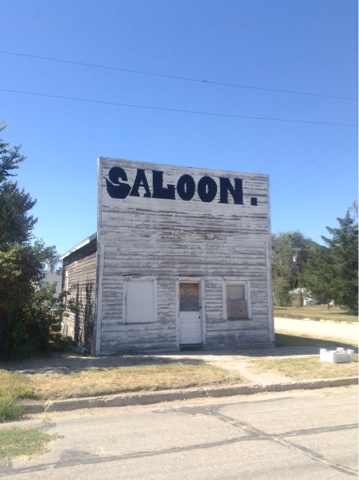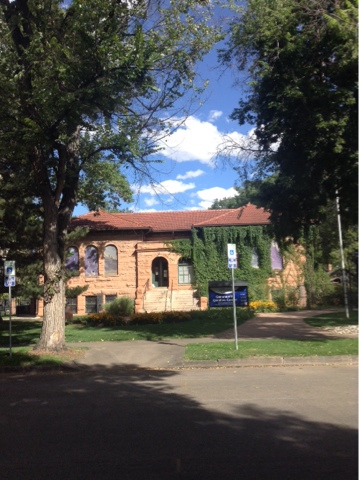Even though Andrew Carnegie provided the funds for 1,679 libraries in the US, doubling the number of public libraries in the country during his era of giving between 1890 and 1920, not every town in the country has a Carnegie, though they could have if they met his simple criteria of providing a parcel of land for the library near its center and passing a bond issue to maintain it amounting to ten per cent per year of his contribution for the construction of the library. He didn't even give away half as much money as he wanted to for libraries.
Still, there are so many of his libraries that when I pass through a town without one, I wonder how they could have missed the boat. The town of Nebraska City on the Missouri River had a good excuse--a local benefactor had already provided them with a most substantial library. Nebraska City was the home of Julius Sterling Morton, a newspaper publisher who was a strong advocate of tree planting and the originator of Arbor Day in 1872. He went on to be the first Secretary of Agriculture in 1893 under President Cleveland. His son founded Morton Salt in Chicago and became someone of great wealth. He funded a grand library in his home town in 1895. It has been added on to and is grander than ever. It screams for attention, unlike the quiet, assured dignity of a Carnegie. It had the ostentation that Carnegie discouraged, though one could hardly argue that an abode for books could be too nice.
Nebraska City made for a fine farewell to Nebraska, though the forty miles leading to it were on a four-lane divided highway with a non-stop din of traffic reverberating in my ears, the least pleasant stretch of my ride across the state, harkening me back to my ride along Colorado's Western Front. I had a good, wide shoulder to ride on, but it didn't provide a distant enough buffer for me to even listen to my wealth of podcasts. I had no viable alternative, as I ducked below Lincoln, having visited its set of Carnegies two years ago. There are few bridges across the Missouri River. I needed to cross at Nebraska City to begin my series of Carnegies along the southern border of Iowa.
My final of seven Nebraska Carnegies came in Crete, seventy miles before leaving the state. Its librarian gave me a brochure detailing its history and the services it offered. It had had a large addition that blended nicely into its original red brick exterior.
Among its amenities was a collection of 120 cake pans for borrowing. "Is that a common feature of Nebraska libraries?" I asked.
"No, I think we're the only library in the state that does it," the librarian replied.
I didn't burst her bubble and tell her about the library in Arapahoe with a similar quantity of pans for its patrons. Instead, I asked, "Are they popular?"
"They are, especially during the holidays."
My route from Crete towards Lincoln included another unexpected stretch of gravel for five or six miles. At least it was hard-packed and had virtually no traffic. But I had to stop and add air to my tires as I had slow leaks in both of them after another encounter with goatheads the night before. When I returned to the road from my cornfield campsite both tires were studded with the pesky little balls of small darts that can leave the barest of pinpricks in one's tubes. I thought I had patched all the punctures, but unfortunately hadn't. No bike shops remain in rural small-town American, but, miraculously, Walmart sells the not so common presta valve tubes, such as I needed, and also patch kits. The first Walmart I came upon was out of the narrower tubes that I prefer, but the slightly wider ones it had in stock sufficed. I thought I had left the goatheads behind me by the time I reached Nebraska. Hopefully they haven't encroached upon Iowa.
I crossed into Iowa over the Missouri River after descending from the bluffs of Nebraska City and a Lewis and Clark park. I had dropped three thousand feet in my four hundred mile ride across the state. It was flat riding through a valley for six miles before turning south for nine miles on the shoulder of a bluff to the town of Hamburg a couple miles north of Missouri and my first Iowa Carnegie of these travels. It was unmarred by additions and stood alone in full small-town glory with the sun setting behind it. It was closed, but its WIFI required no password, so I was able to catch up with Janina on FaceTime. She had the good news that she had completed her Telluride Journal and posted it at http://merelycirculating.com
Ten miles down the road I burrowed into a cornfield for the night. I couldn't sitatute my tent to allow the sun to hit it in the morning and dry the dew, so had to roll it up damp. It was fifteen miles to Shenondoah and its Carnegie.
As I sat on its steps with it closed on Sundays, drinking chocolate milk and eating a peanut butter and banana sandwich, reading a book since its WIFI was blocked, an elderly woman walked by and asked, "Where are you riding to?" After I told her, she said she had walked the Appalachia Trail over twenty years ago when she was sixty. She's not the first such person who I've met in my travels who had accomplished the feat and knew I was someone who would appreciate it. "I did the whole thing and I did it on my own," she added.
"That's impressive," I said. "I know a lot of people try, but not very many complete the whole trail."
"Yes, I'm a tough country girl."
"Do you bike?" I asked.
"I used to, but not since I got a pace-maker. I'd like to talk some more, but I'm on my way to church. Sorry to ask you where you're going. I know its none of my business. I was just curious."
"Not at all. Thanks for telling me about your hike. Its always nice to meet someone who has accomplished that."
"God bless you."
The Carnegie in Clarinda had been converted into a first class art museum by a couple who had grown up in Clarinda and went on to a successful career in aviation in Lincoln, less than one hundred miles away. The library had played an important part in their life's and they were happy to rescue it when it came up for auction a few years ago. The current exhibit included an incinerated Citroen out front, the work of an Argentinian artist that represented the series of car bombings in his country during its years of unrest.
I reached Bedford and its Carnegie as the full moon that would be eclipsed in a few hours began to rise from the horizon in front of me.
With no signs for the library I stopped at the downtown Casey's General Store to ask its whereabouts and also to fill my water bottles. It was across the street on the corner of Jefferson and Madison. It was a perfect example of a Carnegie--eighteen steps up to its entrance flanked by a pair of white globes not yet turned on. Over the entry was "Public Library" and just below the word "Free." Up above was 1916. A plaque acknowledged it as a National Historic Place. To the left was a flag pole. It had no additions other than an air conditioning unit to its rear and a book return box out front.

I pedaled five miles down the road towards the moon until dark and slipped into a little gulley beside a corn field and behind a cluster of trees. An hour later when I was eating my second bowl of ramen and creamed corn I heard a car stop along the road and then saw a bright spot light trying to penetrate the trees. I opened my tent door for a better look. There were actually two cars. Then I heard a voice shouting, "Is anybody down there?" They hadn't actually spotted me, but evidently I had been reported. The officers seemed reluctant to approach me, so I climbed up to the road to face the consequences.
"I'm traveling by bicycle," I explained.
"We know," the young, non-threatening officers responded. "We've had a couple of reports on you. We heard you were at the Casey's in Bedford. People around here are suspicious of strangers. A hitch-hiker passing through here a couple years ago shot some people. Do you have any ID?"
I had it at the ready. As I handed it over I asked, "Do you know how the Bears did today?"
"They we're losing 3-0 at the half."
"Could you ask how the game ended when you call in my license?"
While one officer retreated to his car the other said, "Keep your hands out of your pockets if you would."
"What's the story on the hitch-hiker?" I asked.
"He was an escaped convict from the Clarinda Correctional Facility. He broke into somebody's house and got their guns and used them. He actually shot my partner in the shoulder."
We had the eclipsing moon to watch while we waited the verdict on whether I was wanted. The officer left with me said he thought it would be cool to ride one's bike across the country. He hadn't ridden RAGBRAI, but had many friends who had and knew he'd do it one of these years. When I told him I went to Bedford to see its Carnegie, he said his partner's wife was the librarian there and she was busy getting ready for its 100th anniverary next year.
When the other officer returned he said, "They lost 26-0. You're clear." Then he told his partner they had a domestic dispute to tend to.
"Sorry to put you guys out," I said.
"That's okay. Have a good night."
During the interlude the moon had nearly disappeared. I saw much more of it than if I had been in my tent.
I'm getting used to being checked out by the police. Last year it happened five times in five states--Alabama, Michigan, Colorado, Illinois and Indiana. Like finding neckerchiefs, bungee cords and license plates along the road, its not an official tour until my driver's license has been called in. I just wonder how more frequent it would be if I were another color or wore a turban.



















































